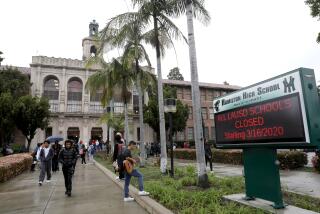Election day was a sweepstakes for schools across California

Conventional political wisdom may have been upended in the race for the White House, but when it came to funding for school construction, a little-known strategy worked like a charm:
Presidential elections are a good time to pass school bonds.
In fact, it was hard last week to find a school or education funding plan that California voters on the state or local level weren’t willing to pay for.
In liberal Los Angeles County, voters approved 28 of 29 school-funding measures. Kern County, a conservative bastion that voted 56% for Republican President-elect Donald Trump, approved 11 of 12 school bonds.
On the statewide ballot, voters passed Proposition 51, which will provide $9 billion in school bonds to be used across California. Voters also approved Proposition 55, which called for extending a tax on the state’s wealthiest residents to provide an estimated $4 billion per year for schools and, to a lesser extent, healthcare.
“Voters said they want to invest in their schools,” said Dennis Meyers, assistant executive director of the California School Boards Assn. “They want new schools. They want modernized schools. They want technology. And most of those local bonds are tied to a match from the state school bonds.”
The electorate is particularly inclined to spend in a presidential election, which draws less frequent and more liberal voters, officials and consultants said.
“Whenever you have a presidential election, that’s when you’re going to get the most voters out there,” said Supt. Martin Galindo of the El Rancho Unified School District, which serves the city of Pico Rivera in southeast L.A. County.
In 2003 and 2010, local voters had approved bond measures to fund the El Rancho district, costing them as much as $120 a year per $100,000 of assessed property value.
Last week, Measure ER sought $200 million more in bonds, mostly for replacing the district’s primary comprehensive high school. Nearly 68% of voters said yes.
District enrollment, which is now about 9,000, has declined between 150 to 250 students per year for the last 15 years. A new high school will offer an up-to-date learning environment, making El Rancho more competitive with nearby districts, Galindo said.
But a second measure — which would have taxed property owners for nine years at a rate of $99 per parcel, bringing in about $1.4 million annually — failed. That money could have been used for any purpose. Parcel taxes require a two-thirds majority, and the measure fell just short, with 65% of the vote.
“We came really close,” Galindo said.
In the nine-campus Los Angeles Community College District, voters approved funding despite problems with past allocations.
While money from a measure passed in 2008 delivered new buildings and needed repairs, the funds also paid for a video biography of the man in charge of construction. And officials had to spend $157,000 to fix a poorly built decorative clock tower. An additional $3.4 million was squandered renovating a theater that then was demolished because officials wanted a brand new one instead. The list of problems goes on.
Still, three in four voters agreed in this election to provide another $3.3 billion.
“From fiber optics to air conditioning, things that most people think are basic to a learning environment, we haven’t always had that,” said Joanne Waddell, president of Local 1521 of the American Federation of Teachers, which represents 5,000 district faculty members.
“We’ve been transforming our campuses, and this will take us to the next step,” Waddell said.
The total of bonds approved for schools across Los Angeles County exceeded $8.2 billion.
L.A. Unified, however, chose not to join the election day sweepstakes because, officials said, it has $6 billion in voter-approved funds still available. The district also will derive some benefit from the new state money.
But with an estimated $40 billion in construction needs, “we will need more in the future,” said Tom Rubin, a consultant to the committee that oversees local bond spending.
In rural Kern County, the new school funding will surpass $1.35 billion. But the $110 million that McFarland Unified had sought to build a new high school isn’t included.
The current campus was built more than 80 years ago to accommodate 600 students, but must house 900. And the school system is continuing to grow.
Local critics labeled the measure “the most expensive in California” because the annual tax rate would have been $240 per $100,000 of assessed property value for 30 years in the low-income community.
The high debt burden required a two-thirds majority rather than the 55% of a typical bond. In the end, 53% voted yes.
“We knew it was an uphill battle,” Supt. Victor Hopper said.
Now he’s developing a less expensive back-up plan — to build a new middle school and convert the existing one into a high school.
The district should qualify for some of the new state bonds to cover part of the cost of his Plan B. But Hopper still would have to turn to voters for more money.
To read the article in Spanish, click here
Twitter: @howardblume
ALSO
California and Trump are on a collision course over immigrants here illegally
Activist who blocked Hollywood development projects launches L.A. council bid
8,000 anti-Trump marchers flood downtown Los Angeles; many fear immigration policies
More to Read
Sign up for Essential California
The most important California stories and recommendations in your inbox every morning.
You may occasionally receive promotional content from the Los Angeles Times.











